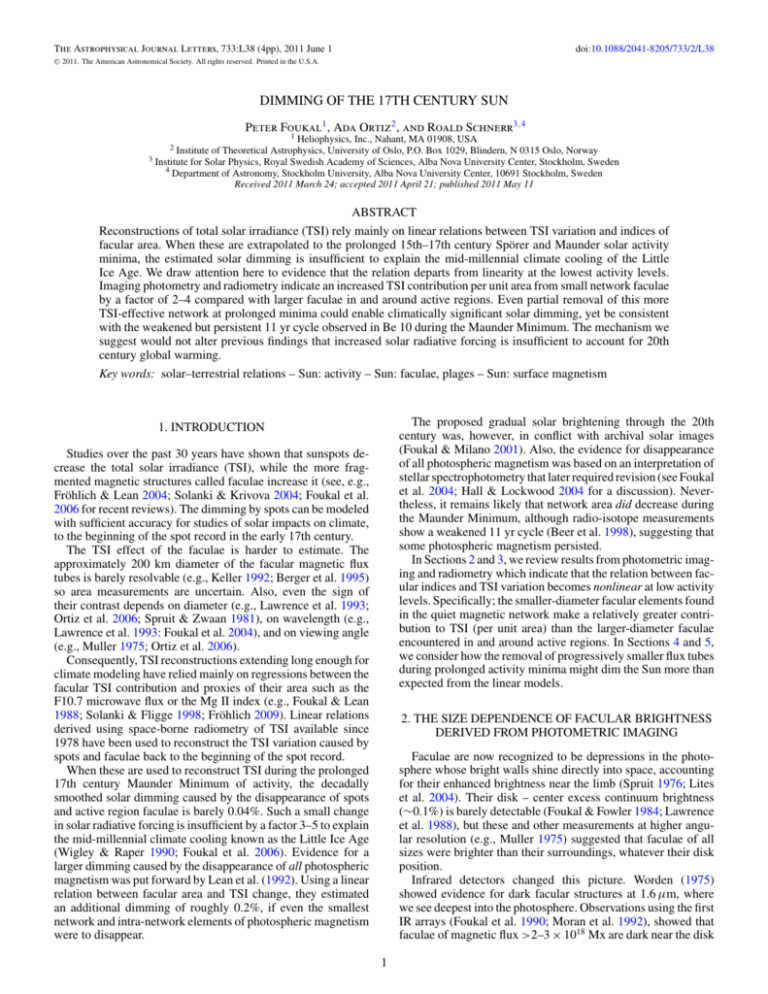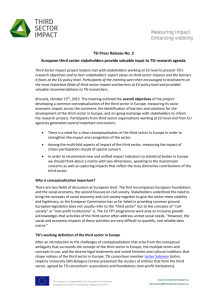
The Astrophysical Journal Letters, 733:L38 (4pp), 2011 June 1
C 2011.
doi:10.1088/2041-8205/733/2/L38
The American Astronomical Society. All rights reserved. Printed in the U.S.A.
DIMMING OF THE 17TH CENTURY SUN
Peter Foukal1 , Ada Ortiz2 , and Roald Schnerr3,4
1 Heliophysics, Inc., Nahant, MA 01908, USA
Institute of Theoretical Astrophysics, University of Oslo, P.O. Box 1029, Blindern, N 0315 Oslo, Norway
3 Institute for Solar Physics, Royal Swedish Academy of Sciences, Alba Nova University Center, Stockholm, Sweden
4 Department of Astronomy, Stockholm University, Alba Nova University Center, 10691 Stockholm, Sweden
Received 2011 March 24; accepted 2011 April 21; published 2011 May 11
2
ABSTRACT
Reconstructions of total solar irradiance (TSI) rely mainly on linear relations between TSI variation and indices of
facular area. When these are extrapolated to the prolonged 15th–17th century Spörer and Maunder solar activity
minima, the estimated solar dimming is insufficient to explain the mid-millennial climate cooling of the Little
Ice Age. We draw attention here to evidence that the relation departs from linearity at the lowest activity levels.
Imaging photometry and radiometry indicate an increased TSI contribution per unit area from small network faculae
by a factor of 2–4 compared with larger faculae in and around active regions. Even partial removal of this more
TSI-effective network at prolonged minima could enable climatically significant solar dimming, yet be consistent
with the weakened but persistent 11 yr cycle observed in Be 10 during the Maunder Minimum. The mechanism we
suggest would not alter previous findings that increased solar radiative forcing is insufficient to account for 20th
century global warming.
Key words: solar–terrestrial relations – Sun: activity – Sun: faculae, plages – Sun: surface magnetism
The proposed gradual solar brightening through the 20th
century was, however, in conflict with archival solar images
(Foukal & Milano 2001). Also, the evidence for disappearance
of all photospheric magnetism was based on an interpretation of
stellar spectrophotometry that later required revision (see Foukal
et al. 2004; Hall & Lockwood 2004 for a discussion). Nevertheless, it remains likely that network area did decrease during
the Maunder Minimum, although radio-isotope measurements
show a weakened 11 yr cycle (Beer et al. 1998), suggesting that
some photospheric magnetism persisted.
In Sections 2 and 3, we review results from photometric imaging and radiometry which indicate that the relation between facular indices and TSI variation becomes nonlinear at low activity
levels. Specifically; the smaller-diameter facular elements found
in the quiet magnetic network make a relatively greater contribution to TSI (per unit area) than the larger-diameter faculae
encountered in and around active regions. In Sections 4 and 5,
we consider how the removal of progressively smaller flux tubes
during prolonged activity minima might dim the Sun more than
expected from the linear models.
1. INTRODUCTION
Studies over the past 30 years have shown that sunspots decrease the total solar irradiance (TSI), while the more fragmented magnetic structures called faculae increase it (see, e.g.,
Fröhlich & Lean 2004; Solanki & Krivova 2004; Foukal et al.
2006 for recent reviews). The dimming by spots can be modeled
with sufficient accuracy for studies of solar impacts on climate,
to the beginning of the spot record in the early 17th century.
The TSI effect of the faculae is harder to estimate. The
approximately 200 km diameter of the facular magnetic flux
tubes is barely resolvable (e.g., Keller 1992; Berger et al. 1995)
so area measurements are uncertain. Also, even the sign of
their contrast depends on diameter (e.g., Lawrence et al. 1993;
Ortiz et al. 2006; Spruit & Zwaan 1981), on wavelength (e.g.,
Lawrence et al. 1993: Foukal et al. 2004), and on viewing angle
(e.g., Muller 1975; Ortiz et al. 2006).
Consequently, TSI reconstructions extending long enough for
climate modeling have relied mainly on regressions between the
facular TSI contribution and proxies of their area such as the
F10.7 microwave flux or the Mg II index (e.g., Foukal & Lean
1988; Solanki & Fligge 1998; Fröhlich 2009). Linear relations
derived using space-borne radiometry of TSI available since
1978 have been used to reconstruct the TSI variation caused by
spots and faculae back to the beginning of the spot record.
When these are used to reconstruct TSI during the prolonged
17th century Maunder Minimum of activity, the decadally
smoothed solar dimming caused by the disappearance of spots
and active region faculae is barely 0.04%. Such a small change
in solar radiative forcing is insufficient by a factor 3–5 to explain
the mid-millennial climate cooling known as the Little Ice Age
(Wigley & Raper 1990; Foukal et al. 2006). Evidence for a
larger dimming caused by the disappearance of all photospheric
magnetism was put forward by Lean et al. (1992). Using a linear
relation between facular area and TSI change, they estimated
an additional dimming of roughly 0.2%, if even the smallest
network and intra-network elements of photospheric magnetism
were to disappear.
2. THE SIZE DEPENDENCE OF FACULAR BRIGHTNESS
DERIVED FROM PHOTOMETRIC IMAGING
Faculae are now recognized to be depressions in the photosphere whose bright walls shine directly into space, accounting
for their enhanced brightness near the limb (Spruit 1976; Lites
et al. 2004). Their disk – center excess continuum brightness
(∼0.1%) is barely detectable (Foukal & Fowler 1984; Lawrence
et al. 1988), but these and other measurements at higher angular resolution (e.g., Muller 1975) suggested that faculae of all
sizes were brighter than their surroundings, whatever their disk
position.
Infrared detectors changed this picture. Worden (1975)
showed evidence for dark facular structures at 1.6 μm, where
we see deepest into the photosphere. Observations using the first
IR arrays (Foukal et al. 1990; Moran et al. 1992), showed that
faculae of magnetic flux >2–3 × 1018 Mx are dark near the disk
1
The Astrophysical Journal Letters, 733:L38 (4pp), 2011 June 1
Foukal, Ortiz, & Schnerr
center, although they are bright in Ca K. Imaging at higher angular resolution showed that their darkness can be detected in the
visible continuum (e.g., Zirin & Wang 1992; Wang et al. 1998).
Since then, several studies (e.g., Lawrence et al. 1993; Ortiz
et al. 2006) have shown that only the smallest faculae, identified
with the magnetic network, are bright across the whole disk.
The chromospheric brightness of the dark faculae leads to their
inclusion in direct and proxy (e.g., Ca K, F10.7, Mg II) measurements of facular area. Therefore, the increasing fraction of
such dark flux tubes decreases the ratio of (TSI contribution)/
(chromospheric facular area index) in faculae larger than the
quiet network.
Skumanich et al. (1975) and Ortiz et al. (2006) reported a
contrast increase with magnetic flux in the network. At their
angular resolution of ∼2 arcsec this reflects an increasing filling
factor of flux tubes in the instrument aperture. The facular flux
tubes are all of ∼1 kG magnetic intensity (Stenflo 1973). So the
magnetic signal is proportional to the sum of their areas and is
insensitive to their size distribution.
Their brightness contrast is, however, dependent upon size
distribution. Models (Spruit 1976) and realistic, extensively
validated three-dimensional simulations (e.g., Keller et al. 2004;
Carlsson et al. 2004) predict that smaller flux tubes should be
brighter per unit area. The main reason is that flux tube heating
by radiation from the bright tube walls (which scales as the tube’s
diameter) becomes increasingly important relative to cooling by
inhibition of convection along the tube’s axis (which scales as
its cross sectional area).
This is supported by the finding of Ortiz et al. (2006) that
the contrast/B (i.e., per unit of magnetic flux) increases with
decreasing flux. Their result refers to contrast measured using
the MDI continuum data at 676.8 nm wavelength, but wideband facular contrasts are likely to be similar since measured
bolometric contrasts lie close to those around the peak of the
H− opacity curve in the red (Foukal et al. 2004).
The Ortiz et al. result is based on maximum contrast measured
on curves of contrast versus heliocentric angle, θ . But their data
can be used to derive a similar result for the excess radiative
flux, ΔF/F, of a facula using the standard photometric relation
Figure 1. Upper panel: normalized excess radiative fluxes, ΔF/F, of faculae
(ordinate) plotted against their magnetic signal, B/μ, corrected for projection.
Lower panel: normalized excess radiative fluxes/corrected magnetograph signal
vs. corrected magnetograph signal. Crosses and dots denote data obtained at
higher (2001) and lower (1998) solar activity.
smaller number of larger ones. This has important implications
for TSI reconstruction at times of low activity.
3. EVIDENCE FROM RADIOMETRY
Some additional support for an increased TSI effectiveness
of the network is suggested by recent analyses of TSI radiometry. The PMOD (Physical-Meteorological Observatory
Davos) radiometric composite shows a TSI decrease during the 2007–2009 activity minimum to values which are
0.016 ± 0.0086% below those recorded in the two earlier
minima (Fröhlich 2009).
This dip is greater than expected from the decrease in
chromospheric proxies of facular TSI contribution (Foukal et al.
2009; Fröhlich 2009). Figure 2 shows this discrepancy using
F10.7 as a linear proxy of the facular TSI contribution. Although
the confidence level of this excess TSI dip is below 95%,
Fröhlich has suggested (see also Steinhilber 2010; Ball et al.
2011; Krivova et al. 2011 for discussion) that it might be caused
by a general photospheric dimming outside of magnetic flux
tubes. Our alternative explanation is that, with prolonged low
solar activity around 2007–2009, the effect of the remaining flux
tubes on TSI increased relative to their effect on chromospheric
and transition radiations used in the proxies.
The increased TSI effectiveness can be estimated by comparing the 20% excess TSI dip to the (only) 5% excess decrease
of a proxy index like F10.7 (Foukal et al. 2009; Fröhlich 2009).
The reproducibility of the radiometry is uncertain at this level,
but the discrepancy is consistent with a TSI contribution of the
network about 2–4 times greater (per unit area) than the contribution of the enhanced network that determines the 11 year TSI
variation (Foukal & Lean 1988). This is about the same factor
by which network flux exceeds active region facular flux in the
photometry discussed in Section 2 above.
ΔF /F = 2π
C(μ)μdμ,
(1)
where C(μ) = (If (μ) – Ip (μ))/Ip (μ) is the contrast of a facula
of intensity If , relative to photosphere of intensity Ip at the
heliocentric cosine μ = cos θ .
Figure 1 shows this normalized excess radiative flux of
individual faculae plotted against their magnetogram signal
ranging from B < 90 G measured in quiet network faculae,
to B = 500–600 G in active region faculae. This signal is
the mean magnetic intensity averaged over the magnetograph
entrance aperture; the network magnetic signal <90 G given
above corresponds to a flux integrated over the aperture of
2 × 1018 Mx. We see in the upper panel that ΔF/F peaks at
intermediate-B values around 350 G. But in the lower panel
we see that the ratio 1/B (ΔF/F) increases monotonically by
about a factor of four between the strongest and weakest facular
magnetic signals.
This result indicates that the excess radiative flux (and TSI
effect) of faculae is not simply proportional to their filling
factor within the instrumental aperture. Removal of a facula
will decrease TSI more if its magnetic signal B arises from a
larger number of smaller flux tubes, than if it arises from a
2
The Astrophysical Journal Letters, 733:L38 (4pp), 2011 June 1
Foukal, Ortiz, & Schnerr
Spruit & Zwaan (1981) found that brightening of smaller
flux tubes is accentuated in the wings of the Mg I b line which
are formed in the high photosphere. So brightening would be
even greater in the ultraviolet continuum formed mainly at
these heights, than in the red continuum observed by Ortiz
et al. (2006). This should further increase the TSI effect of
the network.
In principle, the network TSI contribution is directly measurable from photometric and magnetograph imaging. The required
observations would be photometry covering the broad wavelength range accepted by the radiometers, over the full range
of viewing angle, with sufficient angular resolution (including
magnetograms) to distinguish the smallest faculae. Observations
meeting all of these criteria do not yet exist.
Approximations are, however, available. Schnerr & Spruit
(2011) find a value ∼0.15% from high resolution observations
near 630.2 nm with the Swedish Solar Telescope. Their measurements so far refer only to the disk center; the value would
be higher if measurements closer to the limb were used. It is instructive to compare their value with an estimate obtained from
the lower-resolution MDI data of Ortiz et al. (2006).
The contribution, ΔTSI, of network faculae can be calculated
from the relation (Foukal et al. 1991)
ΔTSI/TSI = f/2 C(μ)(3μ + 2)μdμ,
(3)
(a)
(b)
where the term (3μ + 2) expresses decreasing facular TSI contribution toward the limb due to photospheric limb darkening.
Evaluation of this relation (3) using f and C(μ) from MDI data
at the 1996 solar minimum leads to a value ΔTSI/TSI ∼ 0.01%.
This is an order of magnitude lower than the value of Schnerr
and Spruit.
These authors have shown that their estimate depends upon
angular resolution; it is only about half as large when they use
Hinode data of 0. 32 angular resolution, as it is when the SST
data of 0. 16 resolution is used. One reason is that much of
the oppositely signed, small-scale magnetic structure cancels
out at lower angular resolution. Another is that the brightness
fluctuations are smoothed, so that more are averaged into the
background and removed. These two effects probably explain
why the MDI data of 2 × 2 angular resolution, and using a
relatively high 50 G magnetic threshold, yield a much lower
value.
This comparison illustrates why estimates of the network TSI
contribution obtained using photometry and magnetograms that
do not resolve the smallest solar flux tubes must be considered
as lower limits to the values of roughly 0.2%–0.4% expected if
the network is 2–4 times brighter than larger faculae.
Figure 2. (a) Annual mean PMOD radiometry (squares) and TSI reconstructed
(filled circles). (b) Linear regression of PMOD TSI (corrected for sunspot
blocking) vs. F10.7.
4. THE NETWORK CONTRIBUTION TO TSI
Increased brightness of network faculae is important to TSI
reconstruction if they make a significant contribution to quietSun irradiance; this can be estimated as follows. The measured
11 yr TSI modulation of ∼0.06% amplitude (e.g., Fröhlich
& Lean 2004) arises largely from the solar cycle change in
filling factor of the enhanced network (Foukal & Lean 1988).
An estimate of the quiet network TSI contribution, ΔTSI, can
then be obtained (assuming for now equal brightness of quiet
and enhanced network) from
ΔTSI ∼ 0.06% × (f/Δfe ).
(2)
Here f = A/2π R2 is the filling factor on the hemisphere of quiet
network of area A, R is the solar radius, and Δfe is the change in
filling factor of enhanced network between activity minimum
and maximum. Both f and Δfe are sensitive to angular resolution
and magnetogram threshold, but their ratio is more stable.
Values obtained from MDI data (Ortiz et al. 2006), based
on the definitions of quiet and enhanced network as pixels of
B < 90 G and 90 G < B < 130 G, respectively, yield (f/Δfe ) ∼
1.4 and ΔTSI ∼ 0.09%, which approximately agrees with the
(also linear) estimate by Lean et al. (1992). Our value may
underestimate ΔTSI, since the value of f obtained from the MDI
data of relatively high magnetic threshold is lower than that
obtained from either KPNO magnetograms (Foukal et al. 1991)
or from Ca K images (Foukal & Milano 2001).
But even based on this possibly low linear estimate, if the
quiet network is 2–4 times brighter than the larger faculae in
enhanced network and active regions, we would expect that
ΔTSI should lie approximately in the range between (2 and
4) × 0.09%, therefore between 0.18% and 0.36%.
5. IMPLICATIONS FOR SOLAR DIMMING AT THE
SPÖRER AND MAUNDER MINIMA
In the analysis of Lean et al. (1992) removal of all network
during the Maunder Minimum would decrease TSI by ∼0.1%
below its value at normal sunspot minima. That is, f would
decrease from its solar minimum value f ∼ 0.15 (Foukal et al.
1991; Foukal & Milano 2001) to f = 0. If the network contrast
is twice that of larger faculae, the same 0.1% decrease of TSI
would require a decrease of f by only 50% to f = 0.08 instead
of by 100% to f = 0.
The actual decrease of f during the Maunder Minimum is
unknown. But models of photospheric field evolution indicate a decay time for non-axisymmetric fields of 1–2 years
3
The Astrophysical Journal Letters, 733:L38 (4pp), 2011 June 1
Foukal, Ortiz, & Schnerr
(Wang et al. 2000). This does not take into account the possibility that network fields may be maintained by other mechanisms
than just the decay of active regions (e.g., Schussler & Vogler
2008). Although these mechanisms deserve closer study, a decrease in f by 50% during the many decades long Spörer and
Maunder minima seems not unreasonable considering that the
recent anomalous 5% decrease in facular area proxies occurred
in response to the 2008 minimum that was prolonged by less
than 2 years. Such a decrease in network area, but not a complete
removal, might be consistent with radio-isotope evidence for a
residual 11 year activity cycle during the Maunder Minimum
(Beer et al. 1998).
As mentioned earlier, this 0.1% dimming would act in
addition to the roughly 0.04% decrease of TSI caused by
disappearance of the 11 year cycle in TSI. Climate modeling
indicates that a TSI decrease of roughly 0.15% during the very
broad, 15th–19th century solar activity decline might explain
much of the terrestrial cooling described as the Little Ice Age
(e.g., Wigley & Raper 1990; Foukal et al. 2006).
Solar activity minima between 1914 and 1996 exhibit no
significant secular increase in f (Foukal & Milano 2001). This
argues against a secular increase of TSI due to increasing
network area during the 20th century, as proposed in addition to
11 year TSI modulation by Lean et al. (1995) and by Lockwood
& Stamper (1999). This finding from archival solar images is
supported by the subsequent reconsideration of such additional
secular solar brightening over the past century (Lean et al. 2002;
see also Svalgaard & Cliver 2010).
in network area was about four times more effective in
reducing TSI than expected in the linear models.
5. An increased TSI effectiveness by the factor 2–4 implies
that a climatically significant TSI decrease of roughly
0.15%–0.3% might occur without requiring complete removal of the photospheric magnetic network. Therefore,
significant TSI forcing of climate might have occurred
during the prolonged Spörer and Maunder Minima of the
15th–17th centuries, while still retaining enough photospheric magnetism to modulate the Be 10 isotope record
(Beer et al. 1998).
6. No significant trend is measured in the network area filling
factor over the nine solar minima between 1914 and 1996.
So there is no reason to expect 20th century TSI variation
beyond that generated by the 11 yr sunspot cycle.
We thank C. Fröhlich for discussion of the radiometry
and H. Spruit for helpful comments on this paper. The
work at Heliophysics, Inc., was supported by NASA grants
NNX09AP96G and NNX10AC09G.
REFERENCES
Ball, W., Unruh, Y., Krivova, N., Solanki, S., & Harder, J. 2011, A&A, in press
Beer, J., Tobias, S., & Weiss, N. 1998, Sol. Phys., 181, 237
Berger, T., Schrijver, C., Shine, R., Tarbell, T., Title, A., & Scharmer, G.
1995, ApJ, 454, 531
Carlsson, M., Stein, R., Nordlund, Å., & Scharmer, G. 2004, ApJ, 610, L137
Fligge, M., & Solanki, S. 2000, JA&A, 21, 275
Foukal, P. 1996, Geophys. Res. Lett., 23, 2169
Foukal, P. 1998, Geophys. Res. Lett., 25, 2909
Foukal, P., Bernasconi, P., Eaton, H., & Rust, D. 2004, ApJ, 611, L57
Foukal, P., Bernasconi, P., & Fröhlich, C. 2009, BAAS, 41, 827
Foukal, P., & Fowler, L. 1984, ApJ, 281, 1442
Foukal, P., Fröhlich, C., Spruit, H., & Wigley, T. 2006, Nature, 443, 161
Foukal, P., Harvey, K., & Hill, F. 1991, ApJ, 383, 89
Foukal, P., & Lean, J. 1988, ApJ, 328, 347
Foukal, P., Little, R., Graves, J., Rabin, D., & Lynch, D. 1990, ApJ, 353, L712
Foukal, P., & Milano, L. 2001, Geophys. Res. Lett., 28, 883
Foukal, P., North, J., & Wigley, T. 2004, Science, 306, 68
Fröhlich, C. 2009, A&A, 501, L27
Fröhlich, C., & Lean, J. 2004, A&AR, 12, 273
Hall, J., & Lockwood, W. 2004, ApJ, 614, 942
Keller, C. 1992, Nature, 359, 307
Keller, C., Schüssler, M., Vögler, A., & Zakharov, V. 2004, ApJ, 607, L59
Krivova, N., Solanki, S., & Schmutz, W. 2011, A&A, 529, 81
Lawrence, J., Chapman, G., & Herzog, A. 1988, ApJ, 324, 1184
Lawrence, J., Topka, K., & Jones, H. 1993, J. Geophys. Res., 98, 18911
Lean, J., Beer, J., & Bradley, R. 1995, Geophys. Res. Lett., 22, 3195
Lean, J., Skumanich, A., & White, O. 1992, Geophys. Res. Lett., 19, 1591
Lean, J., Wang, Y–M., & Sheeley, N. 2002, Geophys. Res. Lett., 29, 2224
Lites, B., Scharmer, G., Berger, T., & Title, A. 2004, Sol. Phys., 221, 65
Lockwood, M., & Stamper, R. 1999, Geophys. Res. Lett., 26, 2461
Moran, T., Foukal, P., & Rabin, D. 1992, Sol. Phys., 142, 35
Muller, R. 1975, Sol. Phys., 45, 105
Ortiz, A., Domingo, V., & Sanahuja, B. 2006, A&A, 452, 311
Schnerr, R., & Spruit, H. 2011, A&A, submitted (arXiv:1010.4792S)
Schussler, M., & Vogler, A. 2008, A&A, 481, L5
Skumanich, A., Smythe, C., & Frazier, E. 1975, ApJ, 200, 747
Solanki, S., & Fligge, M. 1998, Geophys. Res. Lett., 25, 341
Solanki, S., & Krivova, N. 2004, Sol. Phys., 224, 197
Spruit, H. 1976, Sol, Phys., 50, 269
Spruit, H., & Zwaan, C. 1981, Sol. Phys., 70, 207
Steinhilber, F. 2010, A&A, 523, A39
Stenflo, J. 1973, Sol. Phys., 32, 41
Svalgaard, L., & Cliver, E. 2010, J. Geophys. Res., 115, AO9111
Wang, H., Spirock, T., Goode, P., Lee, C., Zirin, H., & Kosonocky, W. 1998, ApJ,
495, 957
Wang, Y., Sheeley, N., & Lean, J. 2000, Geophys. Res. Lett., 27, 621
Wigley, T., & Raper, S. 1990, Geophys. Res. Lett., 17, 2169
Worden, P. 1975, Sol. Phys., 45, 52
Zirin, H., & Wang, H. 1992, ApJ, 385, L27
6. CONCLUSIONS
1. Imaging in the near-infrared and visible spectral regions
shows that Ca K faculae of magnetic flux greater than
2–3 × 1018 Mx tend to be dark in the photospheric continuum except near the limb. Only the smallest faculae,
observed in the quiet network and intra-network, are bright
at all disk positions. Analysis of the excess facular radiative flux, ΔF, and magnetic signal, B, in such measurements
shows that the ratio 1/BΔF/F increases with decreasing B.
2. The decrease in B is generally ascribed to decreasing cross
sectional area (rather than decreasing magnetic intensity) of
the kilogauss flux tubes within the measuring aperture. So
brightness per unit area increases with decreasing flux tube
area progressing from the larger faculae in active regions
to enhanced and quiet network. This agrees with flux tube
models and simulations (e.g., Spruit 1976; Carlsson et al.
2004; Keller et al. 2004).
3. This brightening implies that removal of network faculae
decreases TSI proportionately more than removal of the
same area of larger faculae in and around active regions.
Thus, the relation between the TSI contribution of faculae
and their area is no longer linear at the lowest activity levels.
The contrast per unit area of network appears to be greater
than that of faculae in and around active regions, by a factor
of approximately 2–4.
4. The TSI decrease reported by Fröhlich (2009) during the
extended 2007–2009 activity minimum was approximately
four times greater than can be explained using a linear
relation between TSI and proxy indices of facular area.
The author has suggested that although its confidence level
is marginal the discrepancy might imply a general photospheric cooling. We suggest an alternative explanation that,
during the prolonged 2007–2009 minimum, the decrease
4





